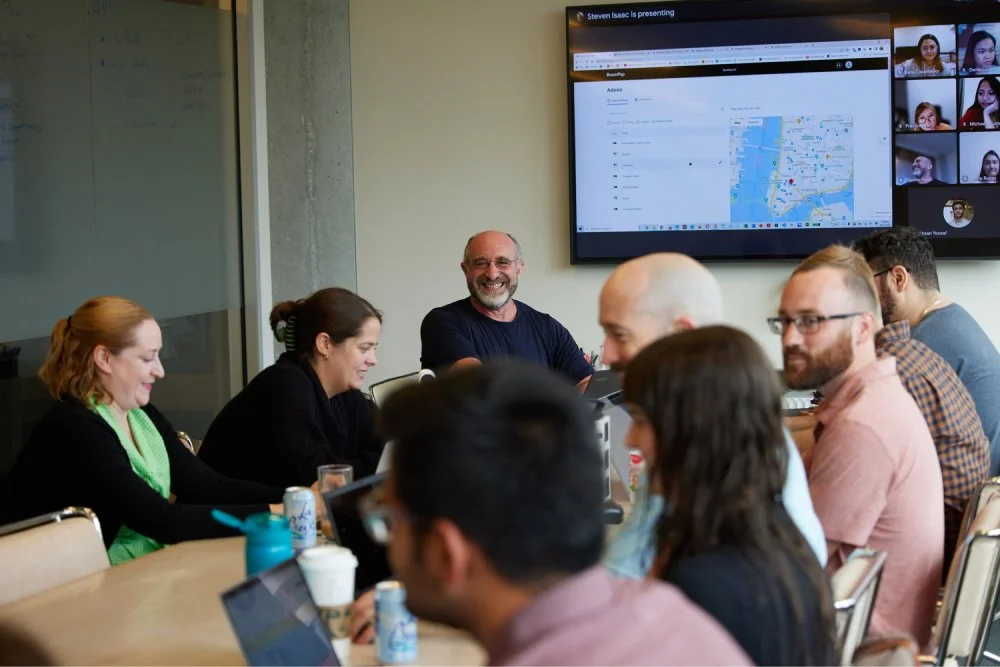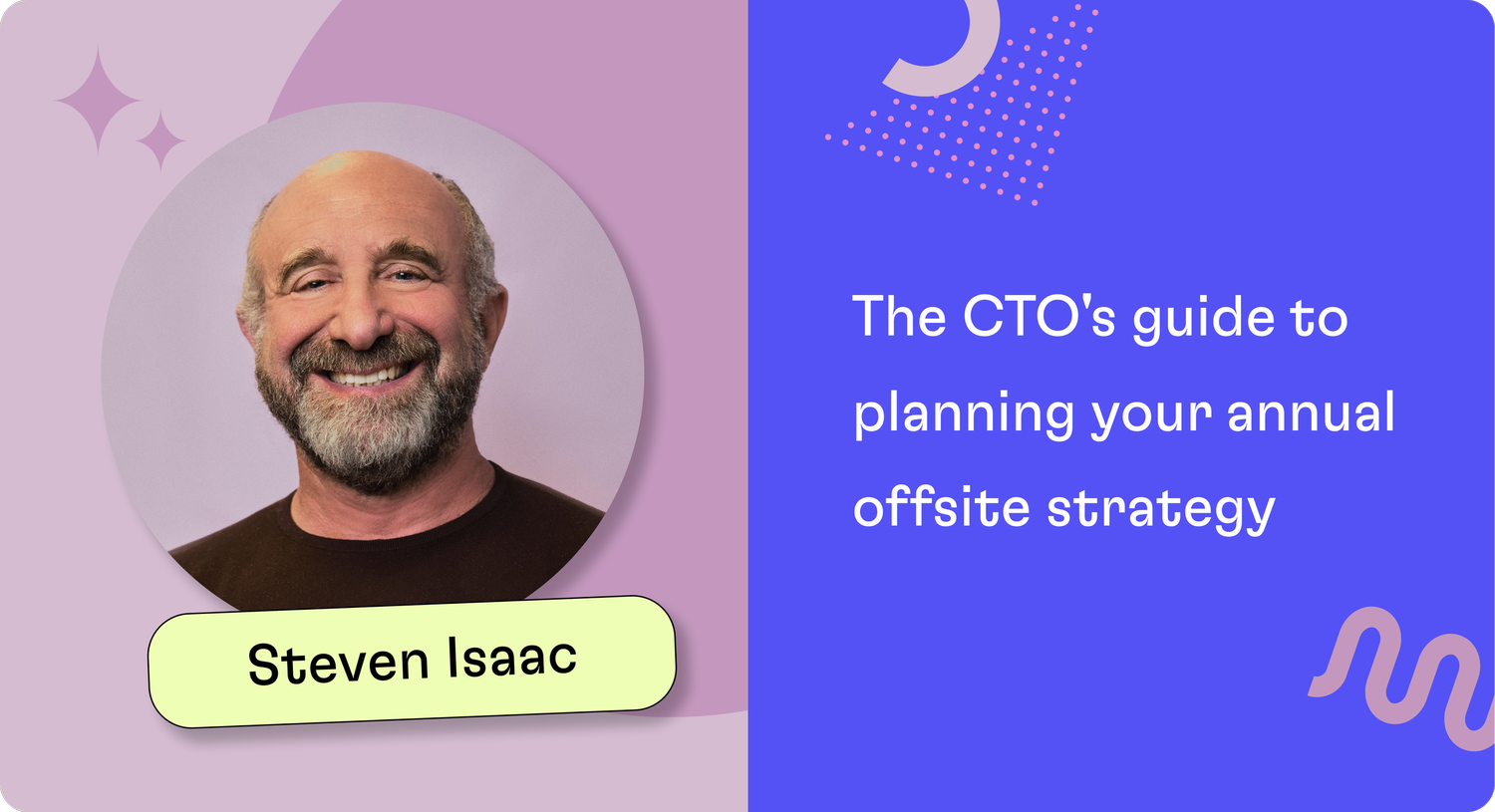The CTO’s guide to planning your annual offsite strategy
Planning
The CTO's guide to planning your annual offsite strategy
Steven Isaac · 1/23/2023Gathering your team in person is a pivotal moment to align, find clarity, and press forward on your goals. Learn how to plan an offsite with maximum impact from BoomPop’s Chief Technical Officer Steven Isaac.
Offsites have exploded in popularity, especially for remote teams. They’re seen as a perk by many employees and they’re often a lot of fun. But that’s just what’s on the surface—and if you stop there, you’re missing out on half the power of what an offsite can be.
This post will help you understand the value of an offsite and create a strategy to extract that value. Before you plan an offsite, though, it’s best to start with a simple question: why have one?
As a technology leader, here’s why my team has offsites—and why I believe they’re particularly important for engineering teams.
Value of offsites for engineers
1. Purpose can get lost in the day-to-day
Engineers can easily get lost in the day-to-day, heads down work of building software. This is an essential part of how technology teams get things done, but especially in a remote work environment, it’s a quick path toward team misalignment.
Offsites are a condensed, impactful way to bring the big picture back into focus. Reminding teams that they are a critical part of a much larger purpose not only helps them understand their value, but ensures those head-down days aren’t wasted on the wrong priorities.
2. The tech environment is always changing
Often, there are big questions a team needs to deal with that are difficult to hammer out remotely. Often, this is exacerbated by the constant change in the tech industry. Things like new releases of technology that’s in your stack or shifting priorities in your company can create concerns for engineers.
Is your work making use of the latest and greatest technology? Are you falling behind? An offsite is an incredibly useful time to zoom out, gain perspective, and make decisions that impact the future of your product and company.
3. Engineering teams can be competitive
There are natural divisions within engineering; front end vs. back end, for example. But there are also competing projects, priorities, and ideas. When you see your coworkers as a Slack avatar first and a human being second, this sense of competition can get worse.
Offsites allow you to connect on a more tangible level. Face to face, it becomes much easier to find common ground, understand differences in focus, and move past development challenges.
Your “why” might be different. What matters is that you have one, and that it forms the basis of how you design offsites. That doesn’t mean designing just one event, but the overarching strategy that guides each one.
With that in mind, let’s walk through how to translate your purpose into strategy.
Offsite strategy essentials
Your first step is to identify how often you will have offsites and what topics those offsites will cover. These two factors should be considered jointly, not separately.
Here’s an example of why: OKRs are one of the most useful things to focus on at your offsite. Because of that, I map my team’s offsites to a quarterly schedule based on when we need to deliver OKRs.
There are also other topics we need to discuss, including:
Our technology stack
Our development process
What we’ve accomplished
What we plan to accomplish
Considering the value-adds above in conjunction with these topics, here’s an example of how our annual offsite strategy might start to shape up.
Q1
Team kickoff
Reflection on prior year
OKR planning
Q2
Tech stack review
OKR planning
Q3
Development process review
OKR planning
Q4
Year end celebration
Annual plan for following year
OKR planning
Once your annual strategy is set, it’s time to consider the best approach to planning each individual offsite.
Offsite planning tips
1. Set the tone early with a meaningful theme
You can start the offsite before it actually begins by setting a theme and assigning your team to form opinions and ideas about it prior to their arrival.
This could be as broad as focusing on a topic like collaboration, or as specific as tackling database architecture, scaling issues, or any number of hurdles your team is facing. Having this theme in place will let you kick off quickly and make progress fast.
2. Create room for organic moments
Especially for remote teams, offsites are a rare and powerful opportunity to strengthen the human connections that make a team successful. Creating goals and expectations for your event is key, but don’t get too bogged down in minute-by-minute details or over-packing your schedule.
I prefer starting each day with structured time in the morning to make sure we’re aligned and covering key topics. In the afternoon, things become more freeform. Spending less structured, more casual time together in between activities and coworking sessions is just as important as your primary content.
3. Get as much one-on-one time as possible
One of the best uses of time at your offsite is to have clear, direct conversations, especially one on one conversations. Natural rapport is often easier to come by across a table than in a Zoom call, and you can use that to your advantage.
If your team is too big to have one on one time with everyone, create a system for dividing things up and spread those interactions out across your quarterly offsite schedule.
4. Capture the moment
Offsites should be meaningful experiences you can point back to and recall the major decisions made, milestones reached, or problems solved. This experience should be important for your team, and that makes capturing it a priority.
Even something as simple as a one page recap can do wonders. Pictures and videos are even better. No matter how you do it, create something that brings back those memories.
Now, let’s apply these ideas and look at our more fleshed out strategy.
Q1: Team cohesion and collaboration
Team kickoff
Reflection on prior year
OKR planning
Structured coworking sessions
Communication styles workshop
One on ones with managers
Q2: Product feature brainstorming
Tech stack review
OKR planning
Brainstorming sessions
Cross-functional sessions with customer-facing teams
One on ones with frontend engineers
Q3: Working smarter
Development process review
OKR planning
Tools and resources audit
One on ones with backend engineers
Q4: Reflection and appreciation
Year end celebration
Annual plan for following year
OKR planning
Q&A session with company leaders
Exciting group activity
Your strategy will be unique, because your team and company are facing unique challenges—but a simple, straightforward strategy like this will get you on the way to planning offsites that are valuable to your team and organization.
If you’re looking for guidance, our offsite planning team can help. Feel free to reach out to our team via the Contact page.



















